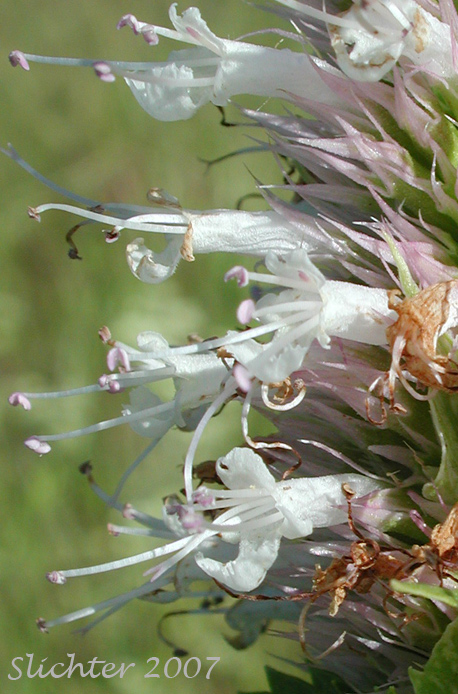 The photo at right shows a close-up of the narrow, tubular flowers of nettle-leaf horse-mint. Photographed at Wilson Creek in central Washington.........June 22, 2006.
The photo at right shows a close-up of the narrow, tubular flowers of nettle-leaf horse-mint. Photographed at Wilson Creek in central Washington.........June 22, 2006.
Nettle-leaf horse-mint is a simple to many branched, green perennial, with square stems extending from 40-140 cm high. Plants are strongly aromatic with the herbage ranging from glabrous to covered with downward facing hairs which are either fine and short or longer, stiff,,, and appressed to the stem. The leaves, which are opposite along the stems, are narrowly to broadly triangular, or heart-shaped in outline with round-toothed margins. The blades range from 3.5-10 cm long and 2-8 cm wide and are strongly net-veined. The petioles measure 1-5 cm long. The leaves are reminiscent to those of stinging nettles, but lack the stingers.
The inflorescence is a dense terminal spike from 3-15 cm long. The calyx is narrowly funnel-shaped, 8-10 mm long, often glandular and often tipped with lanceolate to triangular lobes from 3-5 mm long. The calyx lobes are distinctly 3-veined and often tinged with lavender or purple. The white corolla is narrowly funnel-shaped, two-lipped, and 10-14 mm long (as measured from its base to the tip of the upper lip). The upper lip is 1-2 mm long and shallowly bi-lipped while the lower lip is longer, broader and 3-lobed. The lower pair of stamens ascend and extend 2-3 mm beyond the upper lip while the upper pair of stamens descend and extend past the lower lip from 4-7 mm.
Nettle-leaf horse-mint is a good nectar source for butterflies, often to the extent that is literally covered with fritillaries as well as other species. With its aromatic nature, attractive foliage, and ability to attract butterflies, this species would probably make a good wildflower for the dryland garden. It provides decent forage for cattle and is good forage for sheep, deer and elk. Typically, it increases with overgrazing. The seeds may be eaten both raw or cooked.
Open slopes and draws in sagebrush country, from the foothills to rather high up in the mountains.
Nettle-leaf Horse-mint is found from southeastern British Columbia south through central Washington, extending east of the Cascades through Oregon into California, and eastward to the west slopes of the Rocky Mountains.